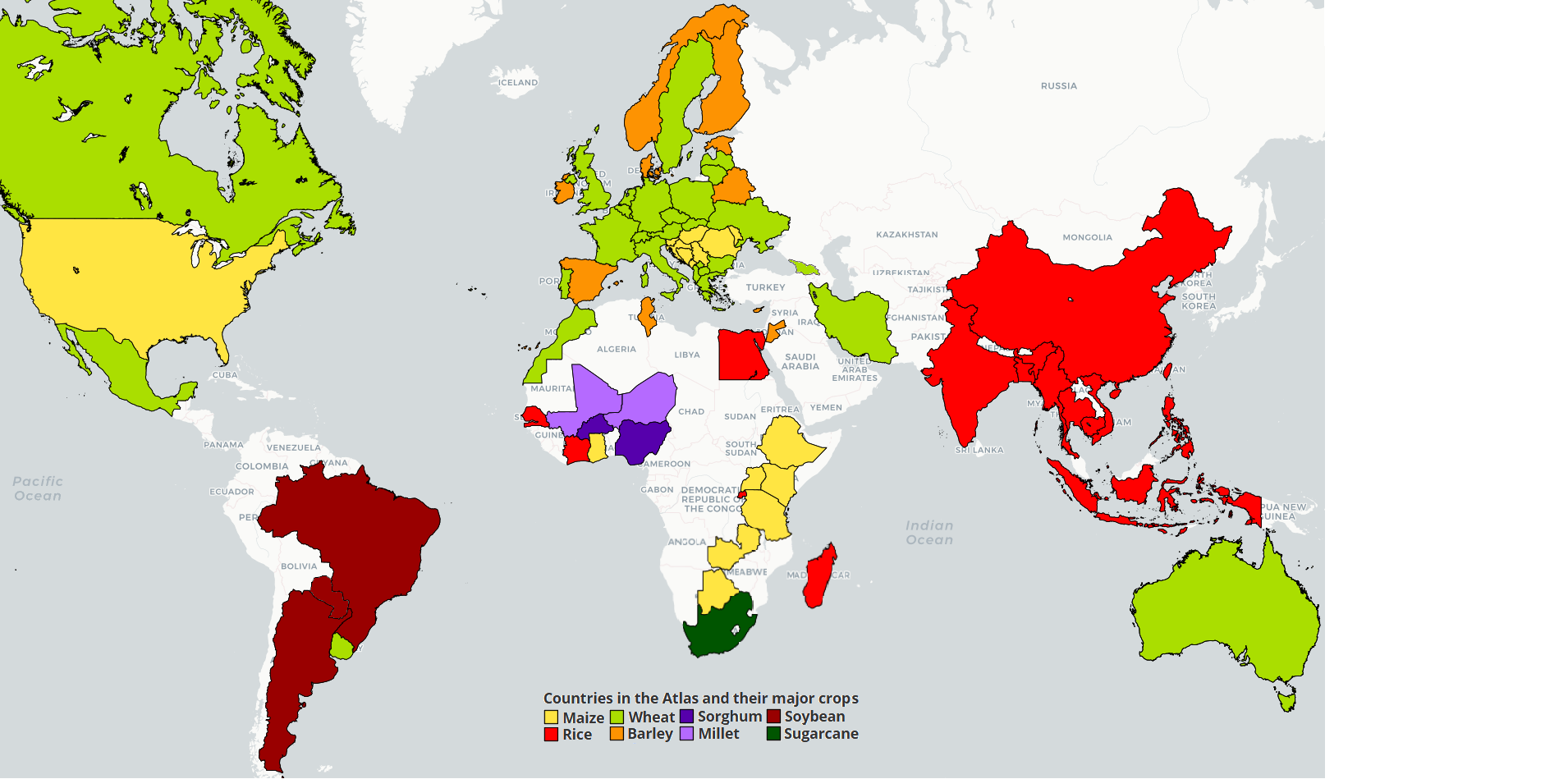 Brazil
Brazil
Write-up Brazil for GYGA
Description of cropping systems, climate, and soils
Annual crop production area in Brazil occupies 69 million ha. Major crops are soybean, maize, sugarcane, and rice which account for 90% of total crop area, and (except for rice) the country is one of the largest producers and exporters of these crops. Most sugarcane, soybean, and maize is produced in rainfed conditions (>90%); rice is produced in irrigated (80%) and rainfed (20%) conditions in the southern and north-central regions, respectively.
Table 1. Average (2015-2019) total production, harvested area, and average yield of soybean, maize, sugarcane and rice in Brazil. Source: CONAB.
| Crop | Total production (MMT) | Harvested area (M ha) | Average yield (t/ha) |
| Soybean | 107.7 | 34.0 | 3.1 |
| Maize | 82.4 | 16.5 | 5.2 |
| Sugarcane* | 651.5 | 8.8 | 73.9 |
| Rice | 11.5 | 1.9 | 5.8 |
* Sugarcane production and yield expressed in stalk fresh mass.
Most part of Brazil has a favorable climate for rainfed crop production, with total annual rainfall that ranges, across the major producing regions, from 700 mm (northeast region) to 2100 mm (south, southeast and west region). Precipitation is well distributed during the year in the south (Rio Grande do Sul, Santa Catarina, and Parana), while it exhibits strong seasonality in the rest of the producing regions, with wet summers and dry winters.
Dominant agricultural soils correspond to the Latosols, Neosols, Argisols and Planosols orders, which covered approximately 70% of the arable land of the country.
Remarkable features of current Brazil agriculture are:
- only 6% of cropland is rented,
- average farm size ranges from 10 ha (north-east) to 1000+ ha (west),
- 50% of the cropland is under no-till,
- soybean is the main crop occupying half of the total cropped area,
- 92% of soybean is transgenic glyphosate resistant while 87% of maize is Bt,
- Dominant agricultural soils have low pH and require continuous lime application.
- While only one crop per year is grown in the eastern part of the country, most producers grow two crops (1-year soybean-maize sequence called ‘safrinha') in the western region (Mato Grosso, Mato Grosso do Sul, Tocantins, Goiás, and Parana).
Data Sources and Assumptions
Harvested area and actual yields
Department-level data on crop harvested area and average yields for each crop was retrieved from the IBGE – Brazilian Institute of Geography and Statistic). Statistics from the most recent six crop growing seasons (harvest years: 2012-2017) were used to calculate crop area and average yields.
Weather data and reference weather stations
Based on crop harvested area distribution and the agro-climatic zones defined for Brazil (Van Wart et al., 2013a), a total of 31 (soybean), 25 (maize), 19 (sugarcane) and 23 (rice) reference weather stations (RWS) were selected. RWS buffer zones accounted for 50, 25, 47, 52 and 15% of total harvested area for rainfed soybean, rainfed maize, rainfed sugarcane, irrigated lowland rice, and rainfed upland rice while the agro-climatic zones where these sites were located accounted for 86, 66, 88, 72 and 63% of national area for these crops. Rainfed rice buffer zones did not attempt to cover cropping areas in Maranhão and northern Pará and Piauí states where rice is grown in flooded conditions in rainfed lowland environments (not uplands).
Long-term (20 years) daily weather data were retrieved from Brazilian Institute of Meteorology (INMET) and include maximum and minimum temperature and precipitation for the period between years 1999 and 2018. Relative humidity, dew temperature, and ETo were estimated following Allen et al., (1998). Quality control and filling/correction of the weather data were performed based on the propagation technique developed by van Wart et al. (2014). In all cases, solar radiation was retrieved from NASA-POWER, which has shown good correlation with measured solar radiation (Bender and Sentelhas, 2018; Monteiro et al., 2018; Duarte et al., 2019). Measured weather data were not available in 20% of the buffers); hence, we used weather data (including all variables) from NASA-POWER.
Soil data
The 1-3 dominant soil series were identified for each RWS buffer based on data from the Radambrasil project (see Cooper et al., 2005). In each buffer, dominant soils were selected to cover at least 30%. Each selected soil had at least 10% of the area. Selected soils were verified by local experts and modified as needed to ensure that simulated soils represented the most common agricultural soils.
For the simulations, rooting depth was set at 2 m (sugarcane), 0.8 m (soybean and maize), and 0.4 m (upland rice) to reflect the limitation to root growth in deep horizons due to low pH and differences among crop species in rooting patterns and/or tolerance to low pH (Pivetta et al., 2011, Battisti et al., 2017; Franchini et al., 2017). Calibrated pedo-transference functions for tropical soils were used to derive soil water limits (Tomasella et al., 2000). Field capacity was set at -10 kPa following the observations for tropical soils by Reichardt (1998) and Tomasella and Hodnett (2004). Soil properties were not considered for simulation of yield potential for irrigated rice.
Crop system and management information for crop simulations
Management practices for each RWS buffer zone were retrieved from local EMBRAPA agronomists and other experts. Requested information include: dominant crop rotations and proportion of each of them to the total harvested area, sowing window, dominant cultivar name and maturity, and optimal plant population density (CONAB, 2019). The provided data were subsequently corroborated by other local and national experts.
Simulations of widespread varieties for each region were performed using Hybrid-Maize model (Yang et al., 2004), CANEGRO (Inman-Bamber, 1991), CROPGRO soybean model embedded in DSSAT v 4.5 (Jones et al., 2003) and ORYZA v3 (Bouman et al., 2004). Genetic coefficients for CANEGRO were derived data from well-managed rainfed and irrigated experiments (Marin et al., 2011, 2012, 2015). Genetic coefficients for soybean were previously derived and validated by Aramburu Merlos et al. (2015) based on data from well-managed rainfed and irrigated experiments in Argentina. Default coefficients in Hybrid-Miaze model (except for those related with phenology) were used for maize simulations. Genetic coefficients for rice were calibrated based on data from previous rainfed and irrigated experiments in Brazil (Heinemann et al., 2019; Ribas et al., 2016; 2017; 2020). Hybrid Maize, CROPGRO and ORYZA models were evaluated on the ability to reproduced measured phenology and grain yields in well-managed experiments across Brazil showing satisfactory performance (see Figure 1). These experiments included a total of 31 site-years in Rio Grande do Sul, Paraná, São Paulo, Goiás, Mato Grosso do Sul, Mato Grosso, Minas Gerais, and Tocantins states (soybean), 9 site-years in São Paulo, Rio Grande do Sul, and Goiás states (maize), 20 site-years in Rio Grande do Sul state (irrigated rice), and 4 site-years in Mato Grosso (upland rice). Experiments for upland rice were not explicitly managed to eliminate yield-limiting factors; as expected, the simulated yield was above the measured yield.

Figure 1. Comparison of simulated and observed phenology (left) and grain yields (right) for rice (top), soybean (middle), and maize (bottom). The solid red line represents y = x and the dashed red lines represents ± 20% deviation from the y -x line. RMSE = mean square root of error. The phenological stages of rice, soybean and maize were based on the scales of Counce et al. (2000), Fehr and Caviness (1977), and Ritchie et al. (1993), respectively.
In order to account for differences in initial soil water at planting time among years, the entire crop sequence (including fallow) was simulated (sugarcane) or simulations were started at sowing assuming 100% of plant available soil water (soybean, rice and maize), which is a very reasonable for maize, soybean, and rice as their sowing coincides with the wet season.
To portray most dominant practices in sugarcane farms, 3 main cycles of ratoon crops of 12-month duration each were simulated at each location: early (April-15), mid (Aug-15), and late planting (Nov 15).
Most typical maize and soybean crop systems were: 2-y soybean-maize (with one crop per year) and 1-y soybean-maize (‘safrinha'). In the latter, soybean is planted with the onset of rains in October and matures in January. Maize is planted after soybean harvest. The rainy season ends before maize maturity, leading to terminal drought in most years. For maize, we simulated both safra and safrinha when both accounted for >30% of maize area within each buffer; if not, only the most dominant maize system was simulated in each buffer.
There are two dominant rice systems: irrigated lowland rice (southern brazil) and rainfed upland rice (north-central and western Brazil). Rice is grown as a single crop per year; in southern Brazil rice is sown from late September to early December and with the onset of rainfall (typically between early November and early December) in north-central Brazil rice is planted. In all cases, rice is direct seeded.
For each crop-RWS combination, each crop sequence x soil type combination was simulated, and then weighted by their relative proportion to retrieve an average Yw at the level of the RWS buffer zone (or Yp in the case of irrigated rice). Simulations assumed no limitations to crop growth by nutrients and no incidence of biotic stresses such as weeds, insect pests, and pathogens.
A weighted average yield was calculated based on the average yield reported for the municipalities located within the buffer zone and the relative contribution of each department to the total crop harvested area in the buffer zone. Reported Yw (or Yp for irrigated rice) in the Atlas are long-term averages. Yield gap (Yg) was calculated as the difference between long-term average Yw (rainfed crops) or Yp (irrigated crops) and average (2012-2017) farmer yield. Including more years before 2012 in the calculation of average actual yield would have led to a biased estimate of average actual yield due to a strong technology trend in Brazil. In the case of buffers where both safra and safrinha were common maize, average maize yield was estimated by averaging their respective average yields, weighting by the proportion of maize area under each crop system.
References:
Allen, R.G., Luis, S.P., RAES, D., Smith, M., 1998. FAO Irrigation and Drainage Paper No.56. Crop Evapotranspiration, Rome, Italy
Aramburu Merlos, F., Monzon, J.P., Mercau, J.L., Taboada, M., Andrade, F., Hall, A.J., Jobbagy, E., Cassman, K.G., Grassini, P. 2015. Potential for crop production increase in Argentina through closure of existing yield gaps. Field Crops Research 184, 145-154.
Battisti, R.B., Sentelhas, P.C., 2017. Improvement of soybean resilience to drought through deep root systems in Brazil. Agron. J. 109, 1612–1622.
Bender, F.D., Sentelhas, P.C., 2018. Solar Radiation Models and Gridded Databases to Fill Gaps in Weather Series and to Project Climate Change in Brazil. Advances in Meteorology, 2018, 1-15.
Bouman, B.A.M.; Kropff, M.J.; Tuong, T.P.; Wopereis, M.C.S.; Ten Berge, H.F.M.; Laar van, H.H, 2004. Van. Oryza 2000: modeling lowland rice. Manila, Philippines: International Rice Research Institute (IRRI). 245 pp.
CONAB, 2019. Calendário de Plantio e Colheita de Grãos no Brasil 2019. Available at: http://www.conab.gov.br
Cooper, M., Mendes, L.M.S., Silva, W.L.C., Sparovek, G., 2005. A national soil profile database for Brazil available to international scientists. Soil Sci. Soc. Am. J. 69, 649-652.
Duarte, Y.C.N., Sentelhas, P.C., 2019. NASA / POWER and DailyGridded weather datasets — how good they are for estimating maize yields in Brazil ? Int. J. Biometeorol. doi: 10.1007/s00484-019-01810-1
Franchini, J.C., Antonio, A., Junior, B., Debiasi, H., Nepomuceno, A.L., 2017. Root growth of soybean cultivars under different water availability conditions Crescimento radicular de cultivares de soja em campo em diferentes disponibilidades hídricas. Ciências Agrárias, Londrina, 38, 715–724.
Heinemann, A. B., Ramirez-Villegas, J., Rebolledo, M. C., Neto, G. M. F. C., & Castro, A. P., 2019. Upland rice breeding led to increased drought sensitivity in Brazil. Field Crops Research 231, 57-67.
Inman-Bamber, N.G., 1991. A growth model for sugarcane based on a simple carbon balance and the CERES-Maize water balance. S. Afr. J. Plant Soil 8, 93–99.
Jones, J.W., Hoogenboom, G., Porter, C.H., Boote, K.J., Batchelor, W.D., Hunt, L.A., Wilkens, P.W., Singh, U., Gijsman, A.J., Ritchie, J.T., 2003. The DSSAT Cropping System Model. Eur. J. Agron. 18, 235–265.
Marin, F. R. Jones, J. W. Royce, F. 2011. Parameterization and Evaluation of Predictions of DSSAT/CANEGRO for Brazilian Sugarcane. Agron. J. 103, 297-303.
Marin, F.R.; Thorburn, P.; Nassif, D.S.P.; Costa, L.G. 2015. Sugarcane model intercomparison: Structural differences and uncertainties under current and potential future climates. Environmental Modelling & Software, 72, 372-386.
Marin, FR, Jones, JW, Singles, A., Royce, F., Assad, E.D., Pellegrino, G.Q., Justino, F., 2012. Climate change impacts on sugarcane attainable yield in southern Brazil. Climatic Change 117, 227-239.
Monteiro, L.A., Sentelhas, C., Pedra, G.U., 2018. Assessment of NASA / POWER satellite-based weather system for Brazilian conditions and its impact on sugarcane yield simulation. Int. J. Climatol. 38, 1571–1581.
Pivetta, L.A., G. Castoldi, G. Santos, and C.A. Rosolem. 2011. Soybean root growth and activity as affected by the production system. Pesquisa Agropecu. Bras. 46, 1547–1554.
Radambrasil Project. 1973–1986. Levantamento de recursos naturais. Vol. 1–34. Inst. Brasileiro Geogr. Estatıstica, Rio de Janeiro, Brazil.
Ramos, J.P.A.; Viana, M.S.; Marin, F.R. 2018. Estimativa da radiação solar global baseada na amplitude térmica para o Brasil. Revista Brasileira de Agrometeorologia, 26, 11-20.
Reichardt, K., 1988. Capacidade de campo. R. Bras. Ci. Solo 12, 211–216
Ribas G.G.; Streck N.A.; Duarte Junior A.; Nascimento M.F.; , Zanon A.J.; Silva, M.R. 2017. Number of leaves and phenology of rice hybrids simulated by the SimulArroz model. Pesquisa Agropecuária Brasileira 51: 1907-1917.
Ribas G.G.; Streck N.A.; Lago I.; Zanon A.J.; Waldow D.A.G.; Duarte Junior A.J.; Nascimento M.F.; Fontana V. 2016. Accumulated dry matter and grain yield in flooded hybrid rice simulated with the SimulArroz model. Pesquisa Agropecuária Brasileira 51: 1907-1917.
Ribas,G.G.; Streck, N.A.; Duarte Junior, A.J.; Ribeiro, B.R.S.M.; Rossato, I.G.; Richter, G.L.; Beixaira, K.P.; Pereira, V.J. Zanon, A.J., 2020. An update of new rice cultivars in the SimulArroz model. Revista Pesquisa Agropecuaria Brasileira (accepted).
Tomasella, J, Hodnett, MG, Rossato, L, 2000. Pedotransfer functions for the estimation of soil water retention in Brazilian soils. Soil Sci Soc Am J 69, 649-652.
Tomasella, J, Hodnett, 2004. Pedotransfer functions for tropical soils. In: Developments in Soil Science, pp. 415-429.
Van Wart, J., Grassini, P., Yang, H.S., Claessens, L., Jarvis, A., Cassman, K.G., 2015 Creating long-term weather data from the thin air for crop simulation modelling. Agric. For. Meteoro. 209-210, 45-58.
Van Wart, J., Van Bussel, L.G.J., Wolf, J., Licker, R., Grassini, P., Nelson, A., Boogaard, H., Gerber, J., Mueller, N.D., Claessens, L., Cassman, K.G., Van Ittersum, M.K., 2013b. Reviewing the use of agro-climatic zones to upscale simulated crop yield potential. Field Crops Res. 143, 44-55.
Yang, H.S., Dobermann, A., Lindquist, J.L., Walters, D.T., Arkebauer, T.J., Cassman, K.G., 2004. Hybrid-Maize: a maize simulation model that combines two crop modeling approaches. Field Crops Res. 87, 131–154.
Get access to the Atlas for advanced users
Download GYGA results
 | Please read the license information in case you are interested in using the data from the Global Yield Gap Atlas. |
| read more>> |
 Country agronomists
Country agronomists
|
Fabio Marin University of São Paulo (ESALQ) |
|
Evandro Henrique Figueiredo Moura da Silva University of São Paulo (ESALQ) |
|
Luís Alberto Silva Antolin University of São Paulo (ESALQ) |
|
Bruna San Martin Rolim Ribeiro Federal University of Santa Maria |
|
Gean Leonardo Richter Federal University of Santa Maria |
|
Rafael Battisti Universidade Federal de Goiás |
|
Geraldo Martha Jr |
|
Alencar Zanon Federal University of Santa Maria |
| Nereu Streck Federal University of Santa Maria |
|
Giovana Ribas Federal University of Santa Maria |
|
Alexandre Heinemann |











